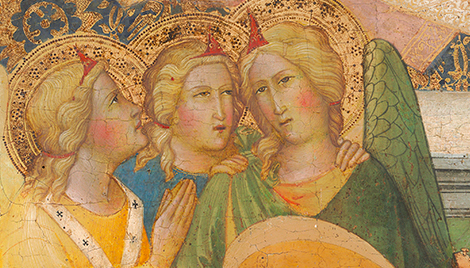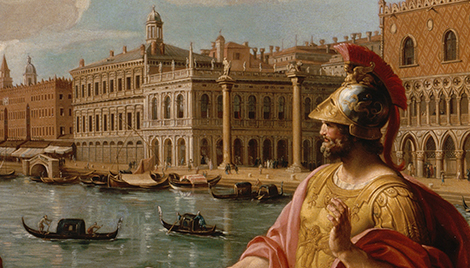Marchesa Brigida Spinola Doria
Marchesa Brigida Spinola Doria
- Artist
- Sir Peter Paul Rubens
- Artist Dates
- 1577-1640
- Artist Nationality
- Flemish
- Title
- Marchesa Brigida Spinola Doria
- Date
- 1606
- Medium
- oil on canvas
- Dimensions
- 152.5 x 99 cm (60 1/16 x 39 in)
- K Number
- K2187
- Repository
- National Gallery of Art
- Accession Number
- 1961.9.60
- Notes
Provenance
The sitter's first husband, Marchese Giacomi Massimiliano Doria [1571-1613, married 9 July 1605], Genoa; by bequest to his brother, Giovanni Carlo Doria [1576-1625], Genoa; [1] passed, probably in 1625, to the sitter's second husband, Giovanni Vincenzo Imperiale [1582-1648, married 4 August 1621], Genoa; [2] probably the sitter, until her death; probably by bequest 1661 to the sitter's stepson and son-in-law, Francesco Maria Imperiale, Mantua; [3] Imperiale Family, Genoa and Mantua; [4] gift from the head of the Imperiale Family to Rati Opizzone's father-in-law; by inheritance to Rati Opizzone, Counselor of the State in Turin, by 1840. [5] Simon Horsín-Déon [1812-1882], Paris, by 1848. [6] J. Pariss, London, by 1854; (sale, Christie & Manson, London, 4 February 1854, no. 76, bought in); purchased after the sale by (Charles J. Nieuwenhuys, Brussels and London), for 60 guineas; [7] (his sale, Christie, Manson & Woods, London, 17 July 1886, no. 92); [8] (Charles J. Wertheimer, London), for 304.10. Probably Lawrence Currie [d. 1934], Minley Manor, Hampshire; by inheritance to his son, Betram George Francis Currie, Minley Manor; (sale, Christie, Manson & Woods, London, 16 April 1937, no. 116); [9] purchased by (Arthur Goldschmidt, London) for (Duveen Brothers, Inc., London and New York); [10] sold 1957 to the Samuel H. Kress Foundation, New York; gift 1961 to NGA. [1] Piero Boccardo, "Ritratti di Genovesi di Rubens e di van Dyck: contesto e identificazioni," in Susan J. Barnes and Arthur K. Wheelock, Jr., eds., _Van Dyck 350_, Hanover and London, 1994: 95-96, note 11. [2] Boccardo 1994, 95-96, note 11. The painting is not mentioned in the inventory made at the death of Giovanni Vincenzo Imperiale in 1648 (Renato Martinoni, _Gian Vincenzo Imperiale - Politio, letterato e collezionista Genovese del Seicento_, Padua, 1983: 231-242). Martinoni also records the date of Giovanni Vicenzo Imperiale's marriage to Brigida Spinola Doria (Martinoni 1983, 48). [3] The Marchesa's death date is not known. The painting was recorded in the 1661 inventory of Francesco Maria Imperiale's collection at his residence in Mantua. See Martinoni 1983, 178-179; Justus Müller Hofstede, "Bildnisse aus Rubens' Italienjahren," _Jahrbuch der Staatlichen Kunstsammlungen in Baden-Württemberg_ 2 (1965): 141 note 15, 143 note 30. [4] After this point in the painting's provenance, contradictory records emerge. In the catalogue of the 17 July 1886 Nieuwenhuys sale at Christie's, the painting is described as having been in the collection of General Sir John Murray, 8th Bart., of Clermont, Fifeshire, Scotland, by 1827, the year of the General's death, and then, by 1830, in the collection of Sir Thomas Lawrence. Yet William J. Bankes apparently saw the Spinola Doria portrait in Rati Opizzone's collection shortly before 1640 (see note 6 below). Thus, it is unlikely that the painting was in General Murray's collection by 1827, as indicated in the 1886 sale catalogue. [5] An undated note written by William J. Bankes of Kington Lacy (in the Bankes papers, Dorset County Record Office), who acquired two full-length portraits by Rubens of Genoese nobility sometime before 1840, reads: "TORINO/ Chevr Rati Opizzone/ Consiller d'Etat à Turin. Rue de la Providence No: 22: has the companion picture by Rubens of the pair which I purchased; portrait of a Lady full length (standing) (with a fan) the same date upon it 1606, & the age, & name of the Lady (Spinola Doria, I think) -- is desirous of selling it; it was a present from the head of the Family Imperiali to his (the Chevr's) father-in-law when the Imperiali was quitting the palace in Campetto." See Gervase Jackson-Stops, ed., _The Treasure Houses of Britain: Five Hundred Years of Private Patronage and Art Collecting_, exh. cat., National Gallery of Art, Washington, D.C., 1985: 558-559, no. 496. [6] P. Hédouin, "Cabinets d'Amateurs. Collection de M. Horsin d'Éon[_sic_]," _L'Artiste. Revue de Paris_ 11 (30 January 1848): 202-203, with a full-length lithograph. Horsín-Déon's description of the painting (Simon Horsín-Déon, _De la conservation et de la restauration des tableaux: elements de l'art du restaurateur..._, Paris, 1851: 35), indicates that the painting was no longer in his possession. [7] The description in the 1854 catalogue of this painting as "whole length" and the sitter "standing on the terrace of a palace" clearly demonstrates that the painting was only cut down after that date. In this sale the portrait of Spinola Doria is offered with its companion, a full-length portrait of the Doge of Genoa that, from its description, is likely the portrait of Spinola Doria's second husband, Giovanni Vincenzo Imperiale, now in the Musée Royaux des Beaux-Arts in Brussels. Christie's records for the sale indicate that both lots were the property of J. Pariss, and that they were both bought in, with lot no. 76 being sold later to Nieuwenhuys (letter of 9 December 1975 from Patrick Lindsay of Christie's to John Hand, in NGA curatorial files). According to Carlotta D'Addato of the Library at Christie's (e-mail of 16 April 1999, in NGA curatorial files), E. McLean, the dealer with whom this painting is often connected in the literature, was an active buyer at the 1854 sale, but did not purchase this work. Ms. D'Addato included in her communication a page partially accounting the sale totals, where lot no. 76 clearly is marked with an x (not sold, or bought in at 70 guineas). This page also includes, in different handwriting, a tally of the sale (668.12.6), and below this an entry for what appears to be NGA 1961.9.60 (76 - 60 - -[guineas] -Nieuwenhuys). The final tally of the sale was thus 728.12.6. It seems that after the sale Nieuwenhuys was able to acquire the painting for 10 guineas less than its buy-in price (see NGA curatorial records). [8] In this sale, the painting was described as being a 3/4 length portrait, which indicates that it had been cut down between 1854, when it was listed as a full length portrait in the sale catalogue, and 1886. Because Charles J. Nieuwenhuys bought the painting in 1854 and it was included in his sale in 1886, he appears to have been responsible for the reduction. However, since Nieuwenhuys was primarily a dealer, he may have sold the painting in the intervening 32 years and reacquired it prior to the 1886 sale. [9] The sale catalogue states that the painting was among the property removed from Minley Manor, the estate of Bertram Currie, esq. In the literature on this painting, Bertram Currie has been interpreted as Bertram Wodehouse Currie, the grandfather of the seller, Bertram George Francis Currie, and thus the painting was thought to have been at Minley Manor through inheritance for three generations. However the Christie's catalogue only states that the sale will include "the properties of Bertram Currie, Esq.," not the estate, which might be the expected term if the property was in fact considered that of the elder Currie, who died in 1896. Three catalogues privately printed by Bertram Wodehouse's son, Lawrence Currie, of the collections in the familial residences of Coombe Warren, Richmond Terrace, and Minley Manor, provide a good picture of the eldest Currie's collection. However, the Rubens is not listed amongst the possessions, which are painstakingly recorded. Indeed, of the 34 paintings and drawings listed in the 1937 catalogue of the sale at Christie's, only five paintings appeared in the Minley Manor catalogue of 1908, one painting in the Coombe Warren catalogue of 1908, and two paintings in the 1909 catalogue of Richmond Terrace. (See Lawrence Currie, _Catalogue of the Collection of Works of Art at Minley Manor_, London, 1908; _Catalogue of the Collection of Works of Art at Coombe Warren_, London, 1908; and _Catalogue of the Collection of Works of Art, &c., at 1 Richmond Terrace, Whitehall_, London, 1909.) It appears likely, then, that probably only after 1909 did Lawrence Currie, or possibly his son Bertram, acquire the bulk of the paintings offered in the 1937 sale. [10] Letter of 30 April 1937 and cable of 7 May 1937, between two of the Duveen Brothers offices (Duveen Brothers Records, Box 286, folder 8, reel 141; accession number 960015, Research Library, The Getty Research Institute, Los Angeles; copies in NGA curatorial files).






